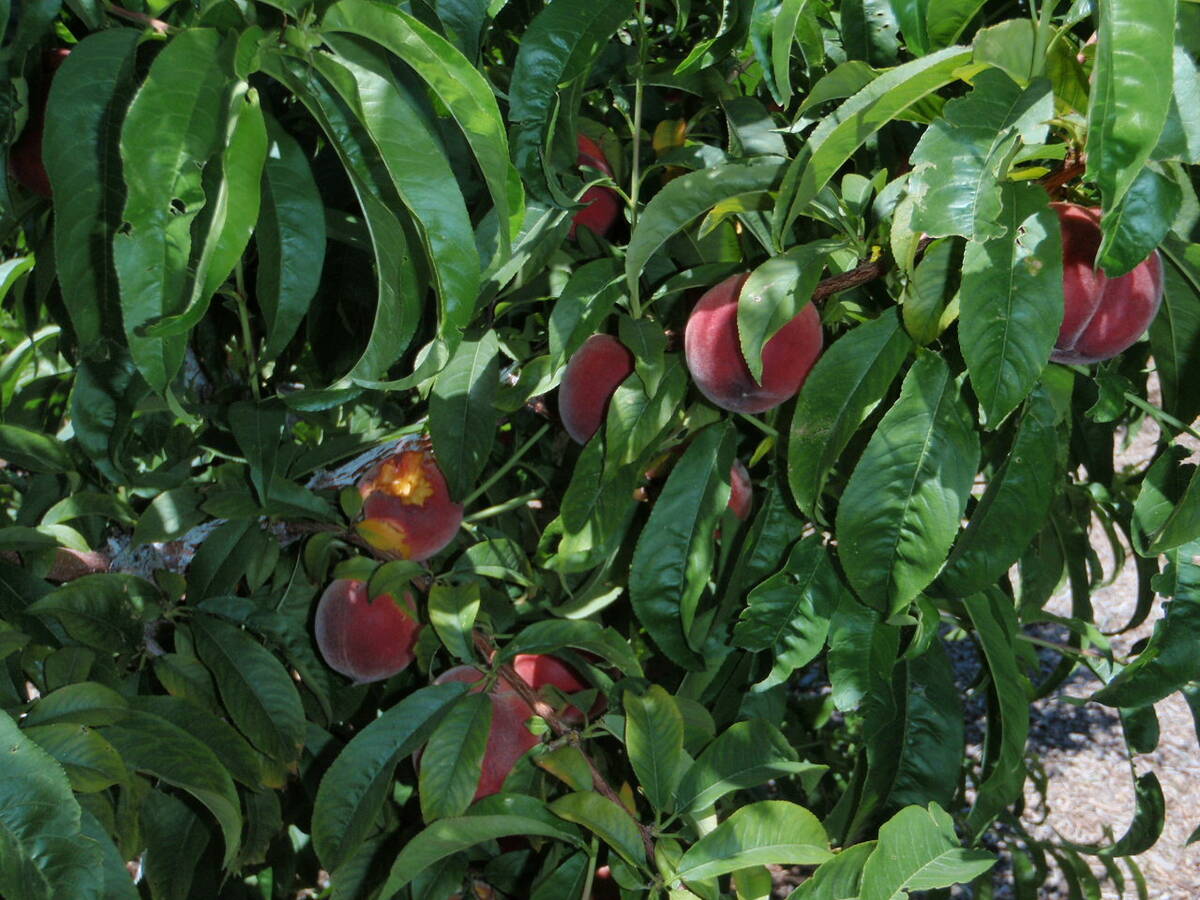Fruit trees that flower early produce fruit early
Q: Several years ago at the university orchard on Horse Drive, you gave us a list of five different peach trees to plant, each ripening at different times. We’ve enjoyed peaches from May through September ever since. Thanks.
A: I prefer to plant entire fruit trees, rather than a single tree with several varieties that ripen at different times of the year for many different reasons. Let’s talk about one of them.
Generally, the varieties of fruit trees that flower earliest produce the earliest fruit. In our climate, peach varieties start flowering the first week of February, and other later-producing varieties of peach may start flowering as late as the end of April. Later-flowering varieties frequently produce fruit later as well.
For example, the peach variety named Earlitreat begins flowering the first week of February. Other early producing peaches such as Florda Prince and FlordaKing start flowering about a week after Earlitreat.
If there is a frost while the flowers are open — early spring through early summer — it produces less fruit or maybe no fruit at all. These varieties of peaches will produce fruit (if frost permits) in mid- to late May until early June.
The variety of peach called Red Baron produces fruit around July but doesn’t begin flowering nearly a whole month later than Earlitreat, in early March. Selecting varieties that flower early or later usually will affect when the fruit is produced.
The missing information is the varieties that taste the best. Each peach variety is different, performs differently in the desert and tastes different.
If a light frost occurs anytime between Feb. 1 and the middle of March (estimated date for our last frost can be as late as March 15), then we will be guaranteed fruit if we are growing several varieties of peach trees in the same location.
Q: I live in Phoenix and question why my Lisbon lemon tree is failing after two years. It flowers in the early spring as it should and produces fruit, albeit, its fruit is nasty and dry. The canopy is about 10 percent of what it should be, and I suspect sunburn has been choking the plant. I think the tree is a goner and thinking of removing it.
A: Yes, I think your tree may be sunburned. Give it a chance. At 2 years of age, you might be able to nurse it back to health if you follow some easy directions.
You live in the northern part of the Sonoran Desert. Las Vegas is on the eastern side of the Mojave Desert. All citrus including Lisbon lemon is subtropical; this means the tree, unlike Meyer lemon, doesn’t survive freezing temperatures very long.
And in your case, it doesn’t do well in our very strong desert sunlight. As the canopy increases in shade and size, giving more shade to the fruit and the tree itself, the fruit will improve. Guaranteed. Don’t let the fruit get overripe before you pick it. That’s a no-no.
Leave the tree shrublike for the first few years until it gets established and then slowly limb it up, making sure the trunk and limbs stay shaded, as it gets older.
Make sure the soil has been amended at the time of planting. This is a subtropical fruit tree and requires more organic matter in the soil than we have in most of our desert soils.
I would not surround this tree with rock or rock mulch on the surface of the soil. Instead, use a layer of 3 to 4 inches of wood chips, keeping the chips away from the trunk for the first few years of its life. As the wood chips on the soil surface decompose or rot in the presence of water, it will slowly add organics back to the soil. Rock doesn’t do that.
The last thing to consider is planting the tree on the north or east side of your landscape, or at least 3 or 4 feet away from a hot west-facing or south-facing wall. It may or may not need it, but it can help the tree.
All fruit trees need about eight hours of sunlight each day, but subtropical trees can do without the 120-degree heat common in Phoenix. If they are in good health, they will withstand the desert heat.
Q: I have a 25-foot saguaro cactus with at least seven arms in my Palm Springs landscape. My gardener just put Roundup around it to control weeds. We had this done a few years ago, and since then the saguaro leans dramatically. I didn’t want him to put it there.
A: I wouldn’t spray Roundup close to it unless you protect the saguaro. It says to protect anything green on the label because it is a general killer. It was developed originally as a grass killer, but it will kill nearly everything if you apply the right concentration.
An older saguaro like yours should be developing some woody brown areas toward the base as parts of it remain green, but that’s not enough. Anything you don’t want to be damaged or killed, protect it.
An easy way to do that is a cardboard barrier to protect the saguaro. After you’re finished spraying you can either remove it or just use it as a shield when you’re spraying Roundup close to it.
Q: A friend gave my husband some fig fruits. This friend said the fig tree is just so full of fruits — enough for all his friends and birds. They’re so sweet, very deep (almost black) purple and small, about an inch around. Can you identify this fig, please?
A: There are many different black or dark purple fig fruit varieties. All the fig varieties do well in Las Vegas if they’re given enough water. I need more to go on than just the size and the color of the fruit. Varieties of black or purple figs include Black Mission, Blackjack, LSU Purple, Violet de Bordeaux, Celeste and others. From your description, my guess would be Black Mission, but it’s just a guess.
Next March try rooting about 10 stem cuttings from the tree if you want to preserve the fruit. You will have to label it “unknown” unless you can discover the variety. Use a rooting hormone like Hormex No. 16 when you root it to improve your chances of success.
Birds can be a big problem because this fruit is ready to harvest the same day birds like them. Unlike some other fruit, figs are what we call “non-climacteric,” which means they must be left on the tree until they are ripe and ready to be harvested. Other non-climacteric fruits include grapes, apples, pomegranates, and a few others.
Q: I have a jasmine plant and it was flowering, but now it’s not and not looking good. What is your call on it?
A: Most times when people say they have a jasmine plant, they mean star jasmine. Star jasmine is not a true jasmine, but the fragrance can be delectable, which is true of most in that plant family.
Star jasmine comes originally from China, so it will like improved soils and dislike rock mulch. Whenever a plant comes from a non-desert area, then try to plant it on the east side of your landscape. This area receives shade in the afternoon and is more hospitable to plants that are not from the desert.
It can be grown as a ground cover or as a vine, but it must be tied to a trellis to get it to perform as a vine.
Most star jasmine in poor health is surrounded with rock mulch. If your star jasmine is in poor health, then surround it with wood chip mulch rather than rock mulch.
When it’s planted, make sure the soil is amended with compost. Dig the hole three times wider than the container or its root system and add the amended soil to this planting hole.
If it’s a 5-gallon or larger plant, then stake it. The wood stake that comes with many local nursery plants is adequate for smaller plants if it is pounded into the solid soil beneath it and retied with nursery tape. Most plants require only one season of staking and then it’s removed.
The only way to re-green yellow leaves is by spraying them with an iron solution. Early next spring, apply any iron chelate to the soil. For difficult yellow plants to “green up,” use the EDDHA iron chelate applied to the soil in the spring.
Bob Morris is a horticulture expert and professor emeritus of the University of Nevada, Las Vegas. Visit his blog at xtremehorticulture.blogspot.com. Send questions to Extremehort@aol.com.





























